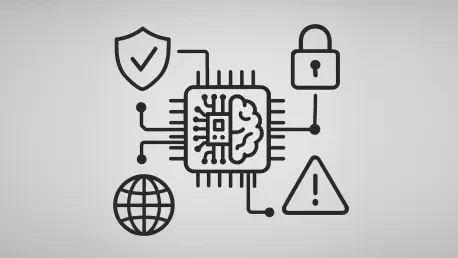In the ever-evolving landscape of artificial intelligence, the Model Context Protocol (MCP) has emerged as a critical infrastructure component, facilitating seamless interaction between AI models and diverse data sources. Recently, however, vulnerabilities in MCP have surfaced, challenging its perceived robustness and prompting questions about the security of AI systems dependent on this technology. These weaknesses, if exploited, can allow unauthorized entities to gain control over AI systems, posing significant risks in applications ranging from customer service bots to sophisticated data analytics. This situation underscores the urgent need to examine the vulnerabilities, analyze responses from the tech industry, and assess the broader implications this has on AI security.
The Crucial Role of the Model Context Protocol
MCP, introduced by Anthropic, functions as an open-source standard designed to enable AI models to securely interact with numerous data platforms. It acts as a universal adapter, much like USB-C does for electronic devices, and allows communication across varied AI applications seamlessly. This protocol supports models such as Anthropic’s Claude in connecting with platforms including Slack, Jira, and customer databases. Its standardized structure provides operational efficiency across its ecosystem, bridging the gap between AI models and the data they utilize. Despite its versatility, MCP’s architecture can become a liability if vulnerabilities arise within its numerous components, which include interfaces and communication protocols linking AI models to data sources.
Uncovering the Vulnerabilities
Recent investigations by cybersecurity firms Tenable and JFrog Security Research have uncovered two critical remote code execution (RCE) vulnerabilities in the MCP framework. These vulnerabilities are cataloged as CVE-2025-49596 and CVE-2025-6514. CVE-2025-49596 impacts MCP Inspector, a vital tool for testing and debugging. It permits unauthorized connections to a proxy-server component, allowing inputs from any IP address without proper authentication. This vulnerability affects versions before 0.14.1, prompting the release of a crucial patch with improved security protocols to address these shortcomings. The second flaw, CVE-2025-6514, affects the mcp-remote proxy that enables communication between large language model hosts and remote MCP servers. This flaw allows command injection that can, in turn, execute operating system commands on compromised client systems.
Scenarios of Exploitation and Potential Consequences
The ramifications of these vulnerabilities are extensive, as exploitation could enable attackers to execute malicious commands or manipulate system responses within a shared network environment. Such attacks potentially occur through man-in-the-middle techniques or carefully crafted HTTP requests, threatening AI systems with unauthorized access or disruptions. The potential for remote exploitation, while more complex, remains a real threat if an attacker can deliver altered data to MCP clients. The risk extends beyond the loss of control over AI models, as compromised systems may yield sensitive information or facilitate further network intrusions. These scenarios highlight the critical need for rigorous security measures and constant vigilance to protect key AI infrastructures from unchecked threats.
Adoption Rates and Emerging Security Challenges
As MCP rapidly gains traction in the AI landscape, its growing adoption presents unique security challenges. Serving as a foundational component in AI processes, it now underpins a vast array of agentic AI workflows with its integration spreading widely. The swift uptake, documented by over 5,000 servers in public registries, signifies a heightened responsibility for organizations to address potential security shortcomings proactively. Notably, a study by GitGuardian has revealed that 5.2% of openly registered MCP servers inadvertently exposed sensitive credentials. Such exposure exceeds typical baselines and could facilitate unauthorized access to vital systems if misconfigurations occur. Many companies have embraced MCP without implementing adequate security policies, leaving them vulnerable to advanced threats like tool squatting, prompt injections, and privilege escalations within LLM-driven MCP environments.
Security Culture and Forward-Thinking Strategies
To effectively counter the vulnerabilities in MCP and ensure a robust defense, security practitioners face the challenge of reimagining MCP servers as critical infrastructure demanding prioritized protection. A comprehensive security approach is needed, akin to measures taken for any vital system infrastructure. These measures include securing interfaces, managing credentials robustly, maintaining audit trails, and enforcing identity-aware access controls. Addressing these foundational elements could provide a safeguard against potential blind spots that malicious actors may exploit. As MCP becomes deeply integrated into AI operations, organizations must focus not just on patch updates but also on adopting a layered security strategy that is adaptive to evolving threats.
Bolstering AI Security for the Future
In the rapidly advancing field of artificial intelligence, the Model Context Protocol (MCP) has become an essential component, ensuring smooth interaction between AI models and various data sources. However, recent discoveries have exposed vulnerabilities in MCP, casting doubt on its robustness and raising concerns about the security of AI systems that depend on this technology. These vulnerabilities can be exploited by unauthorized individuals, enabling them to gain control over AI systems, which presents substantial risks in different applications. This is especially concerning in scenarios from customer service chatbots to complex data analytics systems. The situation highlights the urgent necessity to investigate these weaknesses thoroughly, study the responses from the tech industry, and understand their broader implications for the security of AI systems. Addressing these issues is crucial to maintaining trust and functionality in AI applications, ensuring they remain safe and reliable tools for users. As the industry adapts, ongoing vigilance and innovation are essential.









